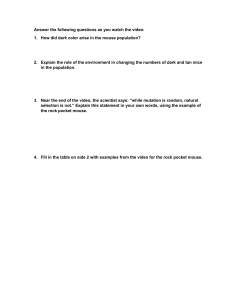

Students then watch the HHMI Video on pocket mice and answer discussion questions. Students also graph the color differences at each location to show how the dark variation increased over time in response to an environmental change. These Sandy light-colored mice are found living in location where they blend in. There have been populations of rock pocket mice that are found to have dark-colored coat. (Cards can be printed and laminated for multiple uses.) Students collect data on the number of mice phenotypes in each location and develop a hypothesis about the order of the cards. Natural Selection and Evolution of Rock Pocket Mouse Populations Observations: Most rock pocket mice have a sandy light-colored coat. Students look at cards showing light and dark mice on different substrates. It has been simplified from the original activity so that it is suitable for beginner biology students. These pocket mice weigh 34 to 50 grams and have a body length of 10 to 14 cm and long tails of up to 16 cm. Habitat is rock ledges, steep rocky ravines, boulders or gravelly slopes, with sparse, shrubby vegetation avoids areas of extensive sand or. Rock pocket mice, Chaeotdipus intermedius, are an ideal. The mutation produced dark colored mice, who were better. The five species of spiny pocket mice (genus Liomys) are found in extreme southern Texas, but they live mostly in Mexico southward to Panama in semiarid brushy and rocky habitats. Abstract: Elucidating the causes of population divergence is a central goal of evolutionary biology. You can find populations of rock pocket mice all over the Sonoran Desert in. How and why has rock pocket mouse population changed over time Asking. This worksheet was modified from the HHMI Activity on color variation in the rock pocket mouse. Why did the MCr1 gene mutation become prevalent in the rock pocket mouse populations answer choices. The rock pocket mouse, Chaetodipus intermedius, usually lives in light-colored rocks and has a correspondingly light coloration (top left). A typical rock pocket mouse is about 170 millimeters long from its nose to. Evolution of dark fur color in rock pocket mice in the southwestern U.S.


 0 kommentar(er)
0 kommentar(er)
